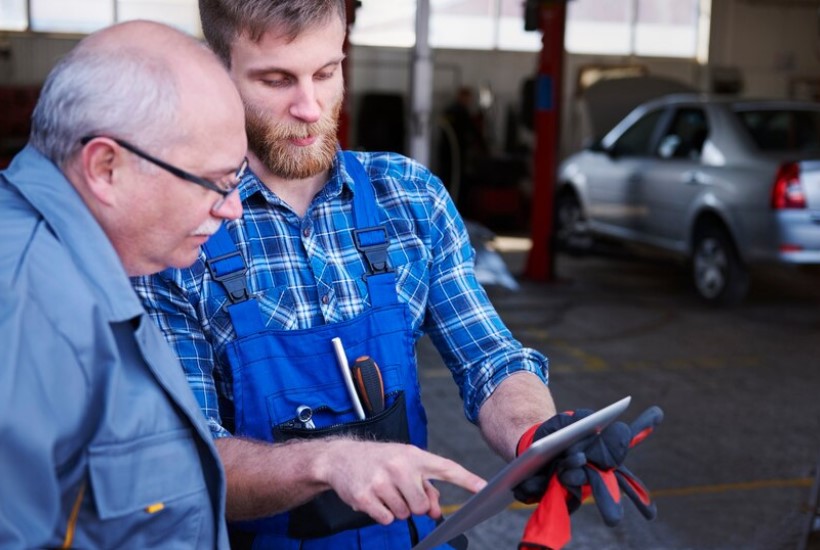Transporting a classic car requires meticulous care and attention to detail, far beyond what’s typical for everyday vehicles. These automotive treasures often hold significant historical, sentimental, and monetary value, making their safe transport a top priority for owners and collectors alike.
Unlike modern cars, classic vehicles are more susceptible to damage from environmental elements, improper handling, and other transport-related risks. This guide explores the essential considerations and steps necessary to ensure that your classic car arrives at its destination unscathed and ready to be enjoyed or further preserved.
From thorough preparation and selecting the right transport method to monitoring the process and conducting meticulous inspections, each aspect plays a crucial role in safeguarding these prized possessions during transit.
Preparing Your Classic Car
Exterior Inspection:
- Scratches and Dents: Carefully examine the entire exterior of the car for any scratches, dents, or dings. Note their location and severity.
- Paint Condition: Assess the paint condition for any chips, fading, or imperfections that could worsen during transport.
- Trim and Chrome: Check the condition of trim pieces, chrome accents, and other external features for signs of damage or loose fittings.
Interior Inspection:
- Cleanliness: Ensure the interior of the car is clean and free of debris. Vacuum if necessary to remove dirt and dust.
- Remove Personal Items: Take out all personal belongings, including loose items like car accessories, tools, or personal effects. Secure any fixed accessories to prevent movement.
Mechanical Inspection:
- Fluid Levels: Check and top off all essential fluids, including oil, coolant, brake fluid, and transmission fluid.
- Battery: Ensure the battery is securely mounted and charged. Consider disconnecting the battery if the car will be in transport for an extended period.
- Tire Condition: Inspect tire tread depth and check for any signs of wear or damage. Inflate tires to the recommended pressure levels.
Undercarriage Inspection:
- Exhaust System: Check for any leaks or damage in the exhaust system.
- Suspension Components: Inspect suspension components for wear or damage that could affect the car’s stability during transport.
Documentation:
- Photographs: Take clear and detailed photographs of the car from multiple angles, focusing on any pre-existing damage.
- Written Notes: Make written notes of the car’s condition, including any imperfections or concerns.
Choosing the Right Transport Method
Enclosed Transport vs. Open Transport
Enclosed transport involves transporting your classic car in a fully enclosed trailer, providing protection from weather elements, road debris, and potential damage. This method is ideal for preserving the pristine condition of valuable and sensitive vehicles, offering peace of mind to owners who prioritize security and protection. When choosing an auto transport company, opting for those that offer enclosed transport ensures the highest level of care for your classic car.
In contrast, Open transport utilizes open-air trailers, making it a more cost-effective option but exposing the car to environmental factors and the possibility of minor cosmetic wear. Choosing between the two depends on factors such as the car’s value, sensitivity to weather and debris, and budget considerations. For classic cars requiring utmost care and preservation, enclosed transport typically offers the best assurance of safe delivery.
Benefits of enclosed transport for classic cars:
Superior Protection: Enclosed trailers shield classic cars from weather elements such as rain, snow, hail, and UV rays. This protection helps preserve the vehicle’s exterior finish, preventing potential damage like paint fading, corrosion, or water spots.
Security: Classic cars are securely housed within an enclosed trailer, reducing the risk of theft or vandalism compared to open-air transport where vehicles are visible and accessible during transit.
Reduced Risk of Damage: Enclosed trailers typically feature softer suspension systems and secure tie-downs that minimize vibrations and movement during transport. This reduces the risk of scratches, dents, or other mechanical damage that could occur with rough road conditions.
Privacy: Enclosed transport offers privacy for your classic car, shielding it from prying eyes and potential unwanted attention during transport.
Customization Options: Some enclosed transport providers offer customizable options such as climate control and specialized padding or flooring to further protect delicate vehicles or those with unique modifications.
Peace of Mind: Owners of classic cars often have peace of mind knowing their prized possessions are receiving the highest level of protection and care during transport, ensuring they arrive in the same pristine condition as when they were loaded.
Considerations for open transport and its risks:
Exposure to Elements: Vehicles transported via open trailers are exposed to weather elements such as rain, snow, dust, and debris. This exposure can lead to potential damage such as paint chipping, water spots, or even more severe issues like hail damage during severe weather conditions.
Risk of Road Debris: Open trailers expose cars to road debris kicked up during transport, including rocks, gravel, and debris from other vehicles. This can result in scratches, dents, or chips on the car’s exterior.
Potential Theft or Vandalism: Classic cars transported in open trailers are visible and accessible, potentially increasing the risk of theft or vandalism compared to enclosed transport where vehicles are more secure and less exposed.
Limited Protection: While open transport providers take measures to secure vehicles with tie-downs and protective coverings, they generally offer less protection against physical damage compared to enclosed trailers with fully enclosed and secured compartments.
Cosmetic Wear: Continuous exposure to wind and road conditions can cause minor cosmetic wear over time, such as small dings or abrasions, particularly on the car’s exterior surfaces.
Suitability for Less Sensitive Vehicles: Open transport is often more suitable for everyday vehicles or those with less sensitivity to environmental factors and minor cosmetic imperfections. Classic cars with high value or delicate finishes may benefit more from the additional protection of enclosed transport.
Selecting a Qualified Transport Company:
Research and Credentials: Look for transport company with specific experience in handling classic cars. Check their credentials, licenses, and insurance coverage to ensure they meet industry standards and regulations.
Reviews and Reputation: Read customer reviews and testimonials to gauge the company’s reliability and customer satisfaction. A reputable car transport company should have positive feedback and a track record of safe deliveries.
Specialized Services: Consider car transport companies that offer specialized services for classic cars, such as enclosed transport options, climate control, and extra padding for added protection during transit.
Communication and Transparency: Choose the best auto shipping company that maintains clear communication throughout the transport process. They should provide you with detailed information on scheduling, tracking options, and what to expect during pickup and delivery.
Cost and Value: Compare quotes from multiple vehicle transport companies, considering not only the cost but also the services included and the level of security and protection offered for your classic car.
Special Considerations During Transport:
During transport, special considerations for classic cars include ensuring they are adequately protected from environmental factors such as weather and road debris. Choosing enclosed transport helps mitigate these risks by providing a secure environment that shields the vehicle from potential damage. Additionally, monitoring the transport process closely and selecting a reputable company with experience in handling classic cars ensures meticulous care and attention throughout the journey, safeguarding the car’s condition and preserving its value.
Insurance Coverage
Insurance coverage for transporting a classic car is essential to protect against potential damages during transit. Ensure the transport company provides adequate insurance that specifically covers classic cars, including comprehensive coverage for damage, theft, or loss.
Verify the coverage limits and exclusions, and consider additional insurance options if necessary to fully protect the vehicle’s value. Clear communication with the transport company about insurance specifics ensures peace of mind that your classic car is covered in case of any unforeseen incidents during transport.
Preparing for Transport Day
Confirm Details: Double-check the transport arrangements, including pickup and delivery times, addresses, and contact information for the transport company.
Prepare Documentation: Gather all necessary documents, including insurance information, vehicle registration, and any paperwork provided by the transport company.
Clean and Inspect: Thoroughly clean the exterior and interior of the classic car. Conduct a final inspection to document its current condition with photos and notes, noting any existing damage.
Remove Personal Items: Remove all personal belongings and valuables from the car. Secure any loose items or accessories to prevent damage during transit.
Prepare Keys: Have a spare set of keys ready for the transport company, including any additional keys for locks or compartments.
Communicate: Stay in communication with the transport company for any last-minute updates or changes. Provide clear instructions and ensure they have all necessary information for a smooth pickup.
Monitoring the Transport Process
Communication: Maintain open communication with the transport company. Obtain a direct contact person and keep their information handy for updates or concerns.
Tracking: If available, use tracking services provided by the car transport companies. This allows you to monitor the progress of your classic car in real-time and anticipate its arrival.
Regular Updates: Stay informed by regularly checking in with the auto transport company for status updates. This ensures you are aware of any delays or changes in the transport schedule.
Documentation: Keep documentation and records of all communications, including emails, messages, and phone calls with the transport company. This helps in resolving any issues that may arise during transport.
Post-Transport Inspection: Upon delivery, conduct a thorough inspection of the classic car. Compare its condition to the documentation taken before transport to ensure it arrived without any new damage.
Receiving and Inspecting Your Classic Car
Initial Inspection: Upon arrival, conduct a visual inspection of the exterior and interior of the classic car. Look for any signs of damage, scratches, dents, or discrepancies compared to pre-transport documentation.
Document Findings: Document any new damage or issues with detailed notes and photographs. This documentation serves as crucial evidence for any potential insurance claims or disputes.
Verify Documentation: Review the delivery receipt and any accompanying paperwork provided by car transport companies. Ensure all details are accurate, including the condition of the car as noted by the transporter.
Address Issues Promptly: If you notice any damage or concerns, immediately inform the transport company. Take note of their response and follow their procedures for filing a claim or seeking resolution.
Complete Transaction: Once satisfied with the inspection and any necessary actions taken, complete the transaction with the vehicle shipping companies. Provide feedback based on your experience to help improve their services.
Conclusion:
Transporting a classic car demands careful planning and attention. From choosing the right transport method and company to inspecting the vehicle on arrival, each step is vital for ensuring the car’s safe arrival. By documenting thoroughly, communicating clearly with the transport company, and taking steps to protect the car, owners can reduce risks and safeguard their vehicle.
Disclaimer
The information provided in this guide is intended to offer general advice on transporting classic cars. While every effort has been made to ensure the accuracy and completeness of the information, individual circumstances may vary. It is essential to conduct thorough research and consult with professional auto transport services to address specific needs and requirements. The author and publisher are not responsible for any losses, damages, or issues arising from the use of this information.
FAQs
1. What are the benefits of enclosed transport?
Ans: Enclosed transport offers protection from weather, debris, and theft, keeping your classic car secure and in pristine condition.
2. How do I choose a transport company?
Ans: Select a company with experience, good reviews, and proper credentials. Look for enclosed transport options and clear communication.
3. How should I prepare my car for transport?
Ans: Inspect and document the car’s condition, remove personal items, check mechanical systems, and prepare necessary paperwork.
4. How can I monitor the transport process?
Ans: Stay in touch with the transport company, use tracking services if available, and keep records of all communications.
5. What if my car is damaged during transport?
Ans: Inspect the car upon delivery, document any damage, report it to the transport company immediately, and follow their claims procedure.

David Weber is an experienced writer specializing in business and related fields, delivering insightful and informative content for diverse audiences.





